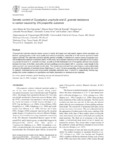Por favor, use este identificador para citar o enlazar este ítem:
http://www.alice.cnptia.embrapa.br/alice/handle/doc/860261| Título: | Genetic control of Eucalyptus urophylla and E. grandis resistance to canker caused by Chrysoporthe cubensis. |
| Autor: | GUIMARÃES, L. M. da S.  RESENDE, M. D. V. de   LAU, D.   ROSSE, L. N.   ALVES, A. A.   ALFENAS, A. C.   |
| Afiliación: | LÚCIO MAURO DA SILVA GUIMARÃES, UFV; MARCOS DEON VILELA DE RESENDE, CNPF; DOUGLAS LAU, CNPT; LEONARDO NOVAES ROSSE, VERACEL; ALEXANDRE ALONSO ALVES, UFV; ACELINO COUTO ALFENAS, UFV. |
| Año: | 2010 |
| Referencia: | Genetics and Molecular Biology, v. 33, n. 3, p. 525-531, 2010. |
| Descripción: | Chrysophorte cubensis induced canker occurs in nearly all tropical and subtropical regions where eucalypts are planted, causing losses in both wood quality and volume productivity, especially so in the warmer and more humid regions of Brazil. The wide inter and intra-specific genetic variability of resistance to canker among Eucalyptus species facilitates the selection of resistant plants. In this study, we evaluated resistance to this pathogen in five Eucalyptus grandis (G) and 15 E. urophylla (U) trees, as well as in 495 individuals from 27 progenies derived from crosses between the trees. In the field, six-months-old test seedlings were inoculated with C. cubensis. Lesion length in the xylem and bark was measured eight months later. The results demonstrated that xylem lesions could preferentially be used for the selection of resistant clones. Eight trees (7 U and 1 G) were susceptible, and the remainder (8 U and 4 G) resistant. Individual narrow and broad sense heritability estimates were 17 and 81%, respectively, thereby suggesting that canker resistance is quantitative and highly dependent on dominance and epistasis. |
| Thesagro: | Controle Genético |
| NAL Thesaurus: | Eucalyptus |
| DOI: | 10.1590/S1415-47572010005000069 |
| Tipo de Material: | Artigo de periódico |
| Acceso: | openAccess |
| Aparece en las colecciones: | Artigo em periódico indexado (CNPF)  |
Ficheros en este ítem:
| Fichero | Descripción | Tamaño | Formato | |
|---|---|---|---|---|
| 2009223.pdf | 164.75 kB | Adobe PDF |  Visualizar/Abrir |









